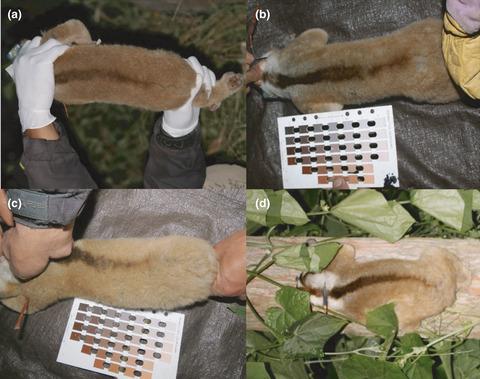当前位置:
X-MOL 学术
›
Ecol. Evol.
›
论文详情
Our official English website, www.x-mol.net, welcomes your feedback! (Note: you will need to create a separate account there.)
Aposematic signaling and seasonal variation in dorsal pelage in a venomous mammal
Ecology and Evolution ( IF 2.6 ) Pub Date : 2021-07-26 , DOI: 10.1002/ece3.7928 K Anne-Isola Nekaris 1, 2 , Marco Campera 1, 2 , Anna R Watkins 1 , Ariana V Weldon 1 , Katherine Hedger 2 , Thais Q Morcatty 1
Ecology and Evolution ( IF 2.6 ) Pub Date : 2021-07-26 , DOI: 10.1002/ece3.7928 K Anne-Isola Nekaris 1, 2 , Marco Campera 1, 2 , Anna R Watkins 1 , Ariana V Weldon 1 , Katherine Hedger 2 , Thais Q Morcatty 1
Affiliation

|
In mammals, colouration patterns are often related to concealment, intraspecific communication, including aposematic signals, and physiological adaptations. Slow lorises (Nycticebus spp.) are arboreal primates native to Southeast Asia that display stark colour contrast, are highly territorial, regularly enter torpor, and are notably one of only seven mammal taxa that possess venom. All slow loris species display a contrasting stripe that runs cranial-caudally along the median sagittal plane of the dorsum. We examine whether these dorsal markings facilitate background matching, seasonal adaptations, and intraspecific signaling. We analyzed 195 images of the dorsal region of 60 Javan slow loris individuals (Nycticebus javanicus) from Java, Indonesia. We extracted greyscale RGB values from dorsal pelage using ImageJ software and calculated contrast ratios between dorsal stripe and adjacent pelage in eight regions. We assessed through generalized linear mixed models if the contrast ratio varied with sex, age, and seasonality. We also examined whether higher contrast was related to more aggressive behavior or increased terrestrial movement. We found that the dorsal stripe of N. javanicus changed seasonally, being longer and more contrasting in the wet season, during which time lorises significantly increased their ground use. Stripes were most contrasting in younger individuals of dispersal age that were also the most aggressive during capture. The dorsal stripe became less contrasting as a loris aged. A longer stripe when ground use is more frequent can be related to disruptive colouration. A darker anterior region by younger lorises with less fighting experience may allow them to appear larger and fiercer. We provide evidence that the dorsum of a cryptic species can have multimodal signals related to concealment, intraspecific communication, and physiological adaptations.
中文翻译:

有毒哺乳动物背毛的警戒信号和季节变化
在哺乳动物中,着色模式通常与隐藏、种内交流(包括警戒信号)和生理适应有关。懒猴(Nycticebus spp.)是原产于东南亚的树栖灵长类动物,颜色对比鲜明,领地意识强,经常进入麻木状态,而且是仅有的七种具有毒液的哺乳动物类群之一。所有懒猴物种都显示出沿着背部正中矢状面从头尾延伸的对比色条纹。我们检查这些背侧标记是否促进背景匹配、季节适应和种内信号传导。我们分析了来自印度尼西亚爪哇的 60 只爪哇懒猴 ( Nycticebus javanicus ) 背部区域的 195 张图像。我们使用 ImageJ 软件从背部毛皮中提取灰度 RGB 值,并计算八个区域中背部条纹与相邻毛皮之间的对比度。我们通过广义线性混合模型评估对比度是否随性别、年龄和季节性变化。我们还研究了较高的对比度是否与更具攻击性的行为或增加的地面运动有关。我们发现爪哇猪笼草的背侧条纹随季节变化,在雨季更长、对比度更大,在此期间懒猴显着增加了它们的地面使用。在分散年龄的年轻个体中,条纹最为鲜明,这些个体在捕获过程中也最具攻击性。随着懒猴年龄的增长,背侧条纹的对比度逐渐减弱。当地面使用更频繁时,较长的条纹可能与破坏性的着色有关。战斗经验较少的年轻懒猴的前部颜色较深,可能会让它们显得更大、更凶猛。我们提供的证据表明,神秘物种的背部可能具有与隐藏、种内通讯和生理适应相关的多模态信号。
更新日期:2021-08-16
中文翻译:

有毒哺乳动物背毛的警戒信号和季节变化
在哺乳动物中,着色模式通常与隐藏、种内交流(包括警戒信号)和生理适应有关。懒猴(Nycticebus spp.)是原产于东南亚的树栖灵长类动物,颜色对比鲜明,领地意识强,经常进入麻木状态,而且是仅有的七种具有毒液的哺乳动物类群之一。所有懒猴物种都显示出沿着背部正中矢状面从头尾延伸的对比色条纹。我们检查这些背侧标记是否促进背景匹配、季节适应和种内信号传导。我们分析了来自印度尼西亚爪哇的 60 只爪哇懒猴 ( Nycticebus javanicus ) 背部区域的 195 张图像。我们使用 ImageJ 软件从背部毛皮中提取灰度 RGB 值,并计算八个区域中背部条纹与相邻毛皮之间的对比度。我们通过广义线性混合模型评估对比度是否随性别、年龄和季节性变化。我们还研究了较高的对比度是否与更具攻击性的行为或增加的地面运动有关。我们发现爪哇猪笼草的背侧条纹随季节变化,在雨季更长、对比度更大,在此期间懒猴显着增加了它们的地面使用。在分散年龄的年轻个体中,条纹最为鲜明,这些个体在捕获过程中也最具攻击性。随着懒猴年龄的增长,背侧条纹的对比度逐渐减弱。当地面使用更频繁时,较长的条纹可能与破坏性的着色有关。战斗经验较少的年轻懒猴的前部颜色较深,可能会让它们显得更大、更凶猛。我们提供的证据表明,神秘物种的背部可能具有与隐藏、种内通讯和生理适应相关的多模态信号。



























 京公网安备 11010802027423号
京公网安备 11010802027423号